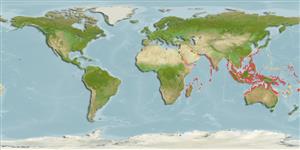>
Gobiiformes (Gobies) >
Gobiidae (Gobies) > Gobiinae
Etymology: Cryptocentrus: Greek, kryptos = hidden + Greek, kentron = sting (Ref. 45335).
Environment: milieu / climate zone / depth range / distribution range
นิเวศวิทยา
เกี่ยวกับทะเล,น้ำเค็ม เกี่ยวกับหินโสโครก; ระดับความลึก 5 - 20 m (Ref. 11441), usually 5 - 15 m (Ref. 9710). Tropical
Indo-West Pacific: East Africa to Melanesia and the Great Barrier Reef.
ขนาด / น้ำหนัก / Age
Maturity: Lm ? range ? - ? cm
Max length : 14.0 cm TL เพศผู้/กระเทย; (Ref. 9710)
Short description
เครื่องมือที่ใช้ในการแยกชนิดสัตว์,สิ่งมีชีวิตออกจากกัน | สัณฐานวิทยา | ความยาวต่างๆ
เงี่ยงครีบหลัง (รวม) : 6 - 7; ก้านครีบอ่อนที่หาง (รวม) : 10; เงี่ยงครีบก้น: 1; ก้านครีบอ่อนที่ก้น: 9. Mostly black with fine pale spotting or white saddles over top of head and back; sometimes yellow (Ref. 30404); further characterized by variable coloration ranging from yellow, entirely blackish, or barred or mottled; dorsal fins unmarked; barred variety with four brown saddles, head with white or bluish streaks, plain dorsal fins, pelvic fins with blue spots, blue stripe on anal fin; saddled variety dark brown color with whitish saddles on top of head and along back; head with small white or blue spots or streaks, pelvic fins with blue spots, blue stripes on anal fins; mottled variety with four diffuse brown bars on side; lower operculum with large brown blotch, head with white to bluish spots, strong mottling on back, anal fin with blue stripes; united pelvic fins, presence of frenum; longitudinal scale series 77-92; absence of scales on head except a few scales dorsally on opercle; greatest depth of body 5.5-5.8 in SL; rounded caudal fin, 3.2-3.8 in SL (Ref. 90102).
Found on sand near patch reefs, usually in 5 m but to at least 15 m (Ref. 9710). Found in burrows with alpheid shrimps (Ref. 2334). Two individuals sometimes share a burrow, and these may be one of each color (Ref. 9360). Occurs in clear coastal and inner reef sand slopes, in small colonies in depth of 6-20 meters (Ref. 48637).
Life cycle and mating behavior
Maturities | การสืบพันธุ์ | Spawnings | Egg(s) | Fecundities | ตัวอ่อน
Randall, J.E., G.R. Allen and R.C. Steene, 1990. Fishes of the Great Barrier Reef and Coral Sea. University of Hawaii Press, Honolulu, Hawaii. 506 p. (Ref. 2334)
IUCN Red List Status (Ref. 130435)
Threat to humans
Harmless
Human uses
การประมง: การค้า; สถานที่แสดงสัตว์และพืชน้ำ: การค้า
เครื่องมือ
Special reports
Download XML
แหล่งที่มาจากอินเตอร์เน็ต
Estimates based on models
Preferred temperature (Ref.
123201): 25.4 - 29.3, mean 28.5 °C (based on 2738 cells).
Phylogenetic diversity index (Ref.
82804): PD
50 = 0.5000 [Uniqueness, from 0.5 = low to 2.0 = high].
Bayesian length-weight: a=0.00708 (0.00333 - 0.01504), b=3.09 (2.92 - 3.26), in cm total length, based on LWR estimates for this (Sub)family-body shape (Ref.
93245).
ระดับชั้นอาหาร (Ref.
69278): 3.4 ±0.4 se; based on size and trophs of closest relatives
ความสามารถในการกลับคืนสู่ปกติ (Ref.
120179): ความสูง, เวลาต่ำสุดที่จะทำให้ประชากรเพิ่มขึ้นเป็น 2 เท่าใช้เวลาน้อยกว่า 15 เดือน (Preliminary K or Fecundity.).
Fishing Vulnerability (Ref.
59153): Low vulnerability (10 of 100).
Nutrients (Ref.
124155): Calcium = 112 [52, 208] mg/100g; Iron = 0.692 [0.364, 1.320] mg/100g; Protein = 18 [16, 20] %; Omega3 = 0.0853 [, ] g/100g; Selenium = 24.1 [12.0, 51.6] μg/100g; VitaminA = 113 [30, 380] μg/100g; Zinc = 1.81 [1.19, 2.67] mg/100g (wet weight);
